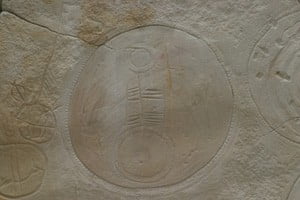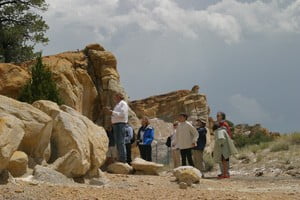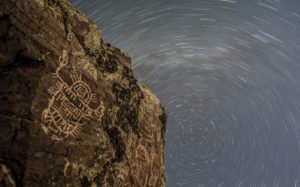August 3, 2015
pet-ro-glyph a rock carving, especially a prehistoric one

The history of those who called Wind River Country home thousands of years ago is scattered across the land. Prehistoric artists carved images into rocks thousands of years ago and historians believe rock art was used to record events, mark important places and serve as an outlet for creative expression. The fact that no one knows the exact significance of these images makes them even more intriguing. You might not be the first to see them, but you can imagine a history of the art that is all your own.
Castle Gardens, named so because the sandstone forms turrets and towers resembling a castle, is one of the finest rock art sites in the state and has some of the finest shield art found in the West.
This style of petroglyphs is known as the Shield Style, depicting warriors with shields, or just the shields alone. They were etched into the rock walls and then painted with pigment made from local minerals leaving traces of color you can still see today. They are believed to date back to 1000 to 1250 AD.

Located 45 miles east of Riverton the site is managed by the Bureau of Land Management and you’ll find picnic facilities and interpretive signs, but be prepared with maps, spare tire, gas, food and water, as it’s off the beaten path, and you might not have cell phone reception. Head south on Highway 789 out of Riverton to Highway 136, also called Gas Hills Road. Turn left and drive 35 miles. Turn left on a dirt road toward Castle Gardens and continue six miles. Turn right at the Castle Gardens sign and drive another five miles to the site.
On the other side of Wind River Country near Dubois, is another must-see area of rock art. These petroglyphs are believed to be the work of the Sheepeater Indians, who called Wind River Country home before the arrival of European trappers and explorers.
Seeing this site takes a little more work, but it’s just as rewarding. Located outside Dubois in the Dinwoody and Torrey basins the best way to see these is through a tour with the Dubois Museum. The half-day trek will take you to the Torrey Lake Petroglyphs. Treks must be made by reservation in advance and the museum recommends a $50 donation for a half-day trip for a group of up to four people.

Expect a moderate hike with some steep climbs while at elevations higher than 8,000 feet. You’ll see ancient images pecked into large boulders scattered throughout the valley. You’ll have plenty of chances to view different types of petroglyphs and learn about theories on their origins from the museum staff member that leads the expedition.
If you get off the beaten path, you’ll get that sense of discovery that makes archaeological sites so special. Please remember that petroglyphs are fragile, non-renewable cultural resources that, once damaged, can never be replaced. We encourage you to respect the beliefs of the descendants of those who carved the images on the rocks.
- Avoid touching. Look and observe but do not touch! Please help preserve the petroglyphs by not touching. Even a small amount of the oils from our hands can darken and destroy the carved image.
- Stay on the trails. For your own safety and the preservation of the petroglyphs, stay on designated trails at all times. Climbing among the rocks can dislodge loose stones causing damage to the petroglyph boulders. Falling rocks can hurt people, or may scratch the carved and pecked images causing unintentional damage. Do not re-arrange the rocks or move/remove artifacts from where you find them.
- Photography and sketching is allowed.
- Where dogs are allowed, please keep them on a leash.